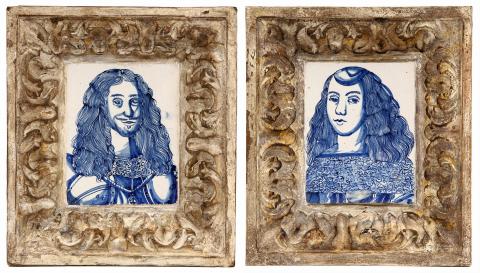Par de Azulejos
Carlos II e Catarina de Bragança, Rei e Rainha de Inglaterra, Escócia e Irlanda
Faiança pintada a azul e vidrada
Holanda ou Inglaterra, ca. 1662
Charles II and Catherine of Braganza, Kind and Queen of England, Scotland and Ireland
Blue painted and glazed faience
Holland or England, ca. 1662
Dim.: 15,6 x 12,3 x 1,5 cm e / and 15,2 x 12,4 x 1,5 cm
Par de Azulejos representando o rei Carlos II (1630-1685) e a rainha, D. Catarina de Bragança (1638-1705), filha do rei D. João IV de Portugal.
A rainha está representada em busto, enquanto Infanta, de torso virado à direita, com penteado tipicamente Ibérico de cabelo longo, volumoso e de ondas paralelas, com grande madeixa encaracolada sobre a testa. Traja gola larga de renda com decote alto, refletindo a moda em Portugal e Espanha, mas afastando-se dos modelos barrocos, de grande exuberância e sensualidade, tão em voga nas cortes europeias, que a rainha irá adotar após a sua chegada a Inglaterra.
Esta imagem, da rainha baseia-se provavelmente numa gravura aberta por William Faithorne (1616-1691), e reproduz parcialmente o retrato a três quartos pintado por Dirck Stoop em 1660/1661, que se encontra na National Portrait Gallery de Londres (NPG 2563).
O rei, igualmente representado em busto, virado à esquerda, enverga gola ou gravata de renda. Sob esta identificam-se ombros de armadura metálica com rebites e colar da Ordem da Jarreteira.
Esta imagem relaciona-se com um retrato de cerca de 1660/1661, certamente pintado pouco depois da restauração, pelo pintor holandês Pieter Nason (1612-1688/90), tendo sido sem duvida copiada de uma das versões desse retrato, abertas por vários gravadores Ingleses e Holandeses tais como David Loggan (1634-1692), William Faithorne (1616-1691) ou Cornelis van Dalen the Younger (1638-1664).
Este tipo de peça comemorativa, celebrando não só o casamento mas também o regresso da monarquia britânica, foi muito popular no período que se seguiu ao início do reinado (1660) e ao matrimónio de Carlos II (1662) com D. Catarina, encontrando-se várias efígies pintados em azulejos, pratos, jarros e canecas de cerâmica, bordados com grande sofisticação sobre suportes têxteis ou cunhados em medalhas. Peças semelhantes no Museu Nacional do Azulejo (Lisboa) provenientes da coleção dos Condes de Penha Garcia (MNAz 690 Az e MNAz 691 Az) e na coleção Berardo (Lisboa).
A pair of tiles portraying king Charles II (1630-1685) and queen Catherine of Braganza (1638-1705), daughter to king João IV of Portugal.
In this bust depiction the queen, portrayed as a Portuguese Infanta, is shown with her torso turning right and with typically Iberian, long and full hair styling, of marked parallel waves and large, curled forehead lock. The high lace neckline, reflecting Portuguese and Spanish fashion, departs from the exuberant and sensual Baroque models fashionable in other European courts, which the queen will adopt soon after her arrival in England.
This image of Catherine of Braganza is based on an engraving by William Faithorne (1616-1691) that part reproduces the three quarter portrait, painted by Dirck Stoop in 1660/1661, today at the National Portrait Gallery in London (NPG 2563).
The king, equally represented in bust but turning left, wears a lace collar or necktie, over a shoulder riveted suit of armour, and the collar of the Order of the Garter. This effigy relates to a portrait painted soon after the Restoration, ca. 1660/1661, by the Dutch artist Pieter Nason /1612-1688/90), and was undoubtedly copied from one of its versions printed by English and Dutch engravers, such as David Logan (1634-1692), William Feithorne (1616-1691) or Cornelis van Dalen the Younger (1638-1664).
This type of commemorative object, celebrating not only the dynastic alliance but also the restoration of the English monarchy, became popular following the reign’s outset (1660) and the king’s marriage (1662). Royal effigies of this type were painted on ceramic tiles, plates, jugs and mugs, embroidered on sophisticated textiles or minted on silver and bronze medals. Similar tiles at the Museu Nacional do Azulejo (Lisbon), originally from the condes de Penha Garcia collection (MNAz 690 Az e MNAz 691 Az), and also at the Berardo collection (Lisbon).
- Arte Portuguesa e Europeia
- Azulejos e Faianças

